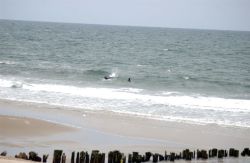Jamaica Bay and the Rockaways
Four Sparrow Marsh Preserve
Named by naturalists Ron and Jean Bourque, Four Sparrow Marsh Preserve is home to four native species which require undisturbed marshland for nesting: Sharptailed, Seaside, Swamp, and Song Sparrows. Because of its relative isolation from residential areas in Brooklyn, Four Sparrow Marsh Preserve has been allowed to remain in a fairly natural condition. This makes it ideal for many permanently nesting species, including several types of ducks, gulls, and wading and woodland birds, as well as for the common seashore mollusks and crustaceans which feed those birds. It is an important part of the Jamaica Bay estuary system.
Jamaica Bay was formed over 5000 years ago as the Laurentide Glacier retreated and melted, depositing fresh water and sedimentary rock. The bay remained relatively undisturbed until the early part of this century, when much of its surrounding wetlands were filled in for development. On the north shore, only two original salt marshes remain. As the larger and older of the two marshes, Four Sparrow serves two critical roles: as a rest stop for up to 326 species of migrating birds on the Atlantic Flyway, and as a “kidney” of shorts, filtering pollution and excess nutrients from the Bay.
From approximately 800 to 1400 A.D. southern Brooklyn was inhabited by members of the Canarsie tribe who probably used the marsh as hunting and fishing grounds. These people were centered at the Keshawchqueren settlement, near present-day Kings Highway and Flatbush Avenue. Archaeological evidence suggests that they dug for oysters and clams, spear-fished, and hunted deer and rabbit. The first Europeans to settle in this area were the Dutch who found the marshy landscape similar to Holland. They formed the town of New Amersfoort in 1647, and established farms to supplement their diet with corn, squash, beans, and livestock. The colonists’ cattle fed on salt hay, unique to coastal areas.
Four Sparrow Marsh Preserve contains several types of habitats besides salt marsh, including low brush; deciduous forest consisting mainly of cherry, elm, locust, poplar, sumac, and willow; open meadow; intertidal mudflat; and high clusters of reed species. The open meadow is largely covered with mugwort, an aggressive, exotic species common in landfilled areas.
This site was transferred to Parks by the City of New York on March 3, 1994 and dedicated on October 29, 1997.
Check out your park's Vital Signs
Clean & Safe
Green & Resilient
Empowered & Engaged Users
Share your feedback or learn more about how this park is part of a
Vital Park System

Know Before You Go
Ecology Park is only open at certain times of year when Parks staff are present in order to protect this unique landscape. Want to visit? Check out our Stewardship Projects page for restoration, planting, and educational events.



